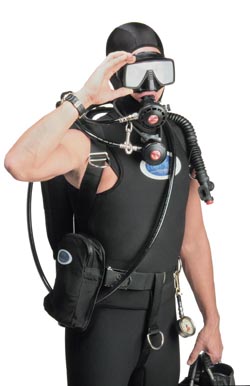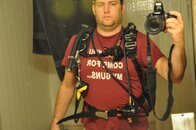Nwcid:
Is anything I have set up unsafe for rec diving and why?
Not necessarily. The argument could be made that there are entanglement hazards, with the extra lengths of line on the light, and particularly on the console. But, in reality, MANY recreational divers go in the water with gear rigged like this and come out alive and happy. Personally, I would not, but that is my choice. And, if you were a diver taking your rig into confined spaces, or penetrating shipwrecks with lots of dangling cables and protruding metal just waiting to snag something, etc, I would give a different answer.
Nwcid:
I agree that the two chest rings is redundant and will probably remove one set. They came like the from the maker so I assume there was a reason for them to be set up that way.
No particular reason, other than a number of divers seem to like having A LOT of D-rings on their rig (to which they can clip all kinds of ‘stuff’), and DR is simply catering to what some customers seem to want. As several have mentioned, there is nothing wrong with that (unless you succumb to the temptation of taking your entire dive box along on every dive, clipped to those D-rings). Like Lynne, I suspect you will find over time you don't need them.
Before offering suggestions - or actually echoing several that have already been made, a general comment: Your preferences are just that – YOURS. Others can offer ideas, but ultimately your rig should reflect what you prefer. So, much of what we say should be taken only as ideas, to possibly try. If you are like most divers, you will find over time that your preferences evolve. That doesn’t make your starting preferences ‘wrong’, rather your tastes change as you gain more experience. And, not all experienced divers have the same preferences. For example, Andy made a comment that your AAS IP hose appears to long, and that he prefers a 24” second stage hose for the bungeed alternate. My initial reaction was just the opposite – it appears too short and will feel awkward in your mouth - the shorter hose will pull your head to the right side). But, neither of us are in as good a position as you are, to determine, in water, whether the hose is too long, too short or just right. Using your picture, here are some thoughts (which have nothing to do with whether your rig should be ‘DIR’ or whether there is a maximum / minimum number of D-rings), most of which have been suggested by others: a) consider removing the top D-ring on the right shoulder strap; b) considering removing the D-ring you added on the left shoulder, as well as the (previously) top D-ring on the left side. That leaves you with 2 D-rings on the straps (one on each side), as well as the swivel rings, which can also be used as an attachment point; c) consider adjusting the length of your HP hose, to allow clipping of the console to a left hip/waist D-ring; d) put a knife, as Andy suggested, or some EMT shears, or a firm-back pocket, or simply clip a reasonably heavy wreck reel, on you right waist strap, and route the long hose under it. And, taking D-rings off doesn't involve tearing your equipment apart - it merely involves taking the shoulder straps out of the tri-glide on each slide, and removing D-rings as you wish. Since you have already added one, I suspect you are already familiar with the process.
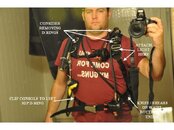
Nwcid:
The flashlight will normally be stowed in the velcro keeper and the shock cord stays tucked right in with it so it is not dangling. What is the advantage of wreck line in this set up?
I suspect you are seeing what has become a somewhat standard preference in the diving community, for static line rather than shock cord. Also, as for the light, I would eliminate the long cord, tie the bolt snap directly to the light (see picture)
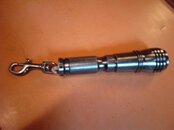
and clip it lower, to the D-ring right above the swivel ring, and secure the lower light head with a piece of inner tube place around the shoulder strap (as Andy also suggested). I have found that, in this position you can use the light, still clipped to the D-ring but released from the inner tube, for ~90% of needs, and you can then unclip it for the uncommon situations where you need to position it farther away from your body. In fact, in one of your pictures, the position of the light is essentially ideal. If you connect it with a bolt snap to the lower D-ring, the position would be the same, but the excess cord would be eliminated. The longer cord, static or shock, is an unnecessary entanglement hazard. Shock cord tends to become less elastic over time and with use, whereas static cord does not.
Your rig brings up another interesting issue, regarding use of a console: Most students train in gear with a 3-gauge console. You finish open water and start to buy gear, and a console seems a logical purchase. Other divers, after gaining some experience, tend to move away from a console, possibly using a wrist computer, a wrist compass, and a simple SPG on their HP hose. I would agree with Andy, the console hose length appears to be substantially longer than is needed. Ideally, the console would run down your left side to a D-ring on the waist strap and be clipped off there. The length of HP hose necessary to do that is ~28-30”. The one possible problem with the shorter hose is that it may limit the effective use of the console compass. So, having a longer hose in that case might be helpful, but the position in which you have placed it provides for both a less than streamlined approach (it will dangle when you are in a horizontal position, and entanglement. Some divers clip the longer HP hose console across their body, and there are pros and cons to that, as Kate pointed out. I generally dive with a SPG on a HP hose, clipped to my left waist D-ring, and wrist computers and compass. But, I also have a pool / OW class rig where I have attached a retractor clip to the end of the console, and the distal end clip to a D-ring on the bottom of my BCD on the right side.
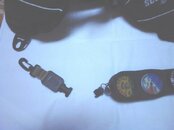
It can be released in two ways – undo the quick release, or unclip it from the D-ring. When I want to look at my gas or depth, I pull the console up, and then let the retractor pull it back into position. But, opinions on retractors also vary (and may be quite strong, either positive or negative).



